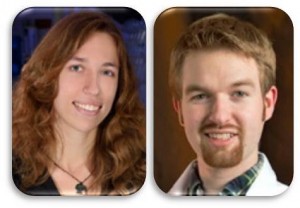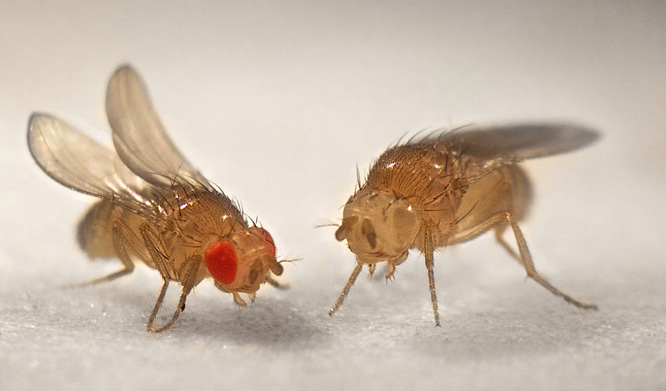In 2014, six undergraduate researchers received Victoria Finnerty Undergraduate Travel Awards, supporting their travel to GSA’s Annual Drosophila Research Conference to present their work. These recipients were among nearly 200 undergraduate students attending the 56th Annual Drosophila Research Conference from March 4-8, 2015, in Chicago, Illinois, providing a robust undergraduate population in a welcoming community of Drosophila researchers. Irina Pushel (Michigan State University) and Alex Kneubehl (Ohio Northern University), two Finnerty Award recipients, recount their experience at the 2015 “fly meeting” for Genes to Genomes.

Irina Pushel (left) and Alex Kneubehl (right), winners of the Victoria Finnerty Undergraduate Award and 2015 Drosophila Research Conference attendees
Irina Pushel (Michigan State University)
This is the second research conference I’ve attended. The first one was actually the Drosophila Research Conference in 2012, my freshman year, where I co-presented a poster with the graduate student I was working with. It was a great experience to come to the same conference, in the same place even, and see the difference that three years makes. I went from acting like a puppy, following around the grad student I was working with, to setting my own agenda and confidently presenting on my own work. I had a much better sense of what was happening and felt like I was able to have meaningful discussions about not only my own work, but also that of other researchers I spoke to. It was a tremendous comparison for me to be able to make. I went from feeling like an outsider three years ago to being embraced as a member of the community now. Allan Spradling’s “call to arms” in his keynote address really made this point hit home for me because even if I’m no longer working with Drosophila when I go off to graduate school next year, it’s still a community that’s shaped my scientific education.
My favorite part of the conference was the ‘Cracking the cis-regulatory code: new computational and physical approaches’ workshop-and not just because it was organized in part by my PI. Every single talk in that workshop focused on incredibly good work, and a variety of different approaches to modeling were shown–some theoretical, some practical, but all very, very cool. As someone who is interested in modeling, and having been involved in a modeling project, this is an area that is highly fascinating for me. It’s an area I’ve been keeping an eye on for the past three years. Seeing the field unfold and more modeling projects spring up is really exciting. It’s also great to see people being so open and embracing sharing data, sharing code, sharing models, and sharing ideas, at a time when so many people are afraid of getting scooped. I fully believe that a collaborative approach is the way to discovery, and it’s wonderful to see this openness and collaboration in the modeling community.
Speaking from two very different experiences at this conference, I have two sets of advice for undergraduates attending the fly meeting.
- First, for someone just getting into research, or new to the field, or new to presenting their work: the most important thing is to not let it intimidate you and to have fun. Look at all sorts of different posters, go to any sessions or workshops that look interesting, talk to people, and don’t be afraid of not understanding everything–people are more than happy to explain their work. In my experience, they get really excited by undergrads just starting research. If you don’t understand the bulk of what’s happening in a session, or it’s just not interesting to you, don’t be afraid to leave. You may not have the background to understand some of the material, and other material may just not be up your alley; there’s no reason to sit through it if it doesn’t interest you.
- The second set of advice is for someone who has been doing research for a while and wants to continue: get as much out of the conference as you can. Network, especially if you know what area you’re interested in pursuing in graduate school, but even if you don’t. Look up poster abstracts and platform sessions ahead of time so you know what you want to do while you’re there. Learn as much as you can. When else will you be surrounded by this many people who love their work and have put aside the time to talk about it? But most importantly, for everyone, have a good time and enjoy the science.
Alex Kneubehl (Ohio Northern University)
As a first time attendee to GSA’s Drosophila Research Conference, I really didn’t know what to expect. I was always told that “the fly people are cool, they come up with protein names like ‘I’m Not Dead Yet’ or ‘Cheap Date’.” I was not disappointed in the creativity and the science being presented at the conference and I was very much impressed overall. Two factors that stood out the most, however, were the sense of community among Drosophilists and the versatility of the fly model.
What struck me as unique about the Drosophila conference was the sense of community. Everyone was passionate about the science, yes, but the sense of togetherness and the close knit community that has been formed within the fly world is really impressive. I can speak for my own lab, a startup Drosophila group, in saying that we have been warmly welcomed and helped immensely along the way. The ready availability of general knowledge and fly lines from the community has been a huge help for our research (especially for a primarily undergraduate institution that can’t readily produce a knock-out fly line!). One only needed to sit in on a few talks to see that such openness and assistance among members of the fly community has only strengthened and furthered fly research as a whole.
A constant topic of discussion was the meaningful use and contribution of Drosophila to science as a whole. As an undergraduate you are taught about the different model organisms and the capabilities of each one to model human diseases or processes, but what is lost is the real versatility of each system— especially Drosophila. I was amazed at our ability to observe neuronal transport through live imaging, the modeling of contact dermatitis, and the parallels between cancer modelling in flies and humans. With each talk I went to, I was continuously impressed with what could be done in the fly model system, and by the parallels between flies and humans. Despite all this, somewhere in the lecture hall and in the media the significance of these model systems (especially Drosophila) is lost, and the focus turns to mammalian models. I am sure that if Rand Paul had been in the audience for many of the presentations at the 2015 Drosophila Research Conference, he may think quite differently about the fruit fly. One need only look at the science generated by the fly community to see that it contributes greatly to endeavors in human health.
My takeaway from the conference: The fly may be small but its impact is mighty and it is here to stay.
The Victoria Finnerty Award depends upon contributions from the community. If you’d like to make a tax-deductible contribution to support this program, please visit GSA’s Donation Form.













